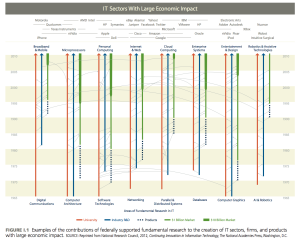The following blog post is by CCC Vice Chair and University of Wisconsin-Madison Professor Mark D. Hill.
I write about a recent Computer Science and Telecommunications Board (CSTB), an operating unit within the National Academies of Sciences, Engineering, and Medicine, workshop report “Continuing Innovation in Information Technology.” This report updates famous “Tire Tracks” diagram for IT (Figure I.1, P. 5). Literally, “tire tracks” is a dense illustration of how federally-funded university research and industrial research and development (R&D) precede the emergence of large IT industries by decades. On one hand, this diagram shows “old” areas like Personal Computers that exceeded $1G annual revenue in the mid-1980s and then exceeded $10G the early 2000s. On the other hand, it shows to “new” areas like Robotics that have reached $1G but not yet $10G. A correction in this version of “tire tracks” places research leading to microprocessors back to 1965, as key computer architecture research predates even the 1971 invention of the microprocessor.
While the “tire tracks” diagram’s data is backward looking—how research greatly precedes large IT industries— it inspires the thoughtful reader to ask two questions of reflection and action:
- Would US leadership in these IT industries have emerged without this funded research?
- Shouldn’t one fund more research now to incubate future $10G IT industries (to be named later)?
The bulk of the report provides a dozen example narratives behind “Tire Tracks.” I see the goal of this to humanize the great progress encoded in the “tire tracks” diagram. The accounts are by Deborah Estrin on application-engaged research, Bob Colwell on IT stack-holder interaction, Farnam Jahanian on unpredictable journeys, Vint Cerf on the Internet, David Culler on beyond the Internet of Things, Andrea Goldsmith on wireless networks, Margaret Martonosi on hardware power limits, Thad Starner on wearables, Jaime Carbonell on machine learning, Eric Horvitz on artificial intelligence, Rodney Brooks on robotics, Stefan Savage on cyber-security, Scott Hudson on user-centered design, and Duncan Watts on the influence of social science. Each story is inspiring in its own way!
As a scholar, I thought that it would be interesting to gather into one place the six “tire tracks” diagrams (so far). Perhaps most striking is how much computing has broadened since the 1995 categories of timesharing, graphics, networking, workstations, windows, RISC, VLSI design, RAID, and parallel computing. Thank you to Helen Wright for unearthing these.










